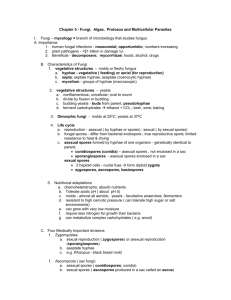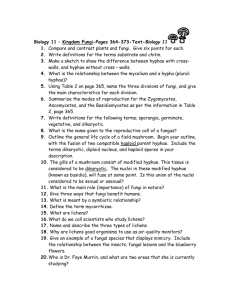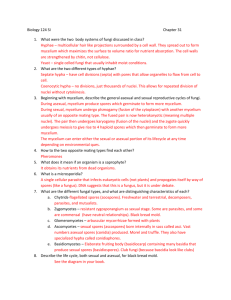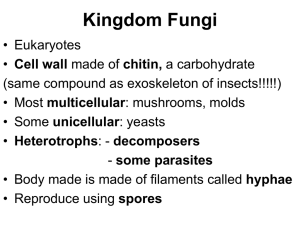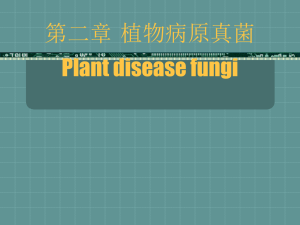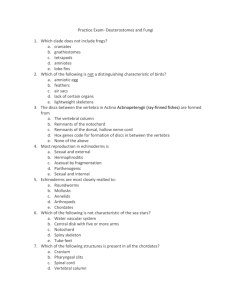Mycology
advertisement
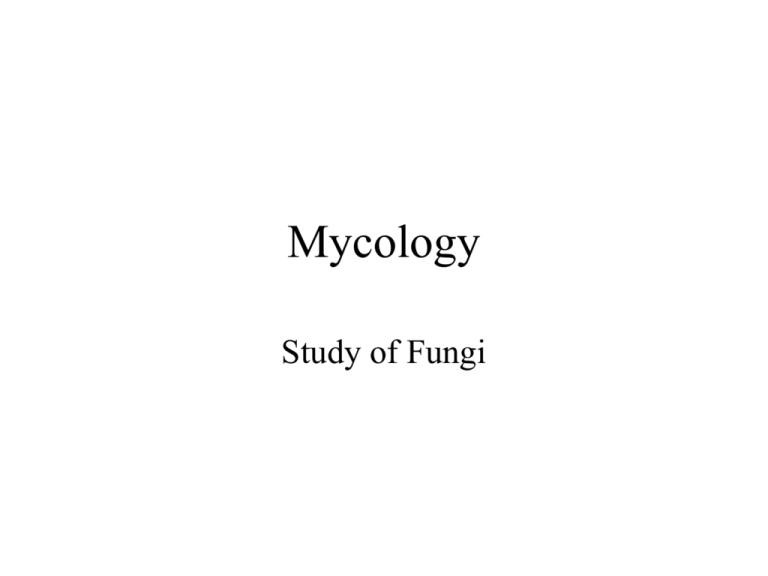
Mycology Study of Fungi Characteristics • Diverse group of chemoheterotrophs – > 90,000 known species • Saprophytes – Digest dead organic matter • Parasites – Obtain nutrients from tissues of organisms • Molds & mushrooms are multicellular • Yeasts are unicellular Significance • Beneficial – Decompose dead organisms – Recycle nutrients – Mycorrhizae • Association with roots of vascular plants-truffles & oak • Assist in absorption of water & minerals – Control of pests -Gypsy moth – Food & antibiotics Parasitic Fungi • Fungal diseases of plants, animals, humans, & bacteria – – – – – – Irish & potatoes Dutch elm disease Death of chestnut trees Crop damage-wilts, mildews Spoilage of food- bread, oranges, jams Athlete’s foot, aspergillosis Nutrition • All are chemoheterotrophs • Absorption of nutrients: powerful exoenzymes • Grow at lower pH-5 than bacteria • Grow in high salt and sugar • Metabolize complex CH2O like lignin in wood-wood rot Structure of Fungi • Vegetative structures involved in catabolism and growth • Thallus- in molds and fleshy fungi – Tubular filaments of cells-hyphae – Septate hyphae - cross walls that divide them into unicellullar units • Pores to allow cytoplasm & nuclei to pass – Coenocytic hyphae- no septa, continuous cells with many nuclei Growth • Elongate at tips of hyphae • Mycelium- filamentous mass of hyphae visible to eye • Aerial hypha or fruiting body- portion concerned with reproduction – Some mycelium underground – Asexual & sexual spores Yeasts • • • • • Unicellular fungi Budding yeasts-uneven cell division Protuberance forms -bud Nucleus divides & one goes into bud Cell wall material laid down Pseudohypha • Elongated chain of cells – Candida albicans -buds fail to detach – Allows yeast to invade deeper tissues • Fission yeast – Divide evenly like bacteria – Visible growth on medium-colony Dimorphic Fungi • Two forms of growth • Grow either as a mold or as a yeast • Dimorphism in pathogenic fungi is temperature dependent – at 37 C yeast like growth – at 25 C it is mold like • Nonpathogenic: CO2 conc – Mucor: on surface yeast, in agar mold Reproduction • Filamentous fungi – Asexually by fragmentation of hyphae – Asexual and sexual reproduction by spores • Yeasts – Asexually by budding or fission – Sexual reproduction by spores Asexual Spores • Produced by aerial hyphae: adapted for dispersal • Progeny genetically identical to parent • Several types – Conidiospores- not enclosed in a sac • produced in a chain at end of a conidiophore • Several types – Sporangiospores • Within a sac, sporangium • End of sporangiophore Sexual Spores • Three phases of development – Plasmogamy-haploid nucleus of a donor cell (+) penetrates the cytoplasm of a recipient cell (-) – Karyogamy- the 2 nuclei fuse to form a diploid nucleus – Meiosis-diploid nucleus gives rise to haploid nuclei – Sexual spores, some + , some -,some recombinants – Sexual spores used to classify fungi into divisions Classification: Phylum • Zygomycota -saprophytic molds, coenocytic hyphae • Rhizopus - black bread mold – asexual spores are sporangiospores – sexual spores are zygospores -large spore enclosed in a thick wall - fusion of nuclei of 2 cells Ascomycota • Sac fungi includes molds with septate hyphae and some yeasts • Talaromyces – – – – asexual spores are conidiospores Sexual spores-ascospores 8 produced in sac –ascus Ascus occurs in fruiting body-ascocarp Basidiomycota • Club fungi, mushrooms, toadstools • Septate hyphae • Sexual spores- basidiospores produced externally on base pedestal-basidium • 4 per basidium • Some produce asexual conidiospores or fragmentation Sexual Reproduction • Telomorphs-produce both sexual and asexual spores • Anamorphs- lost ability to reproduce sexually-Penicillium – belonged to Deuteromycota – now classified as anamorphs of other phyla: rRNA & Woese – most are ascomycetes Fungal Diseases • Mycosis- fungal infection – < 100 cause human disease – Not highly contagious – Humans acquire from nature • Groups based on degree on tissue involvement and mode of entry • Cutaneous mycoses-dermatophytes – Epidermis, hair & nails – Contagious-direct or indirect contact – Secrete keratinase that degrades keratin Cutaneous Mycoses • Tinea( worm) capitis –blisters with scaly ring • Ringworm of the scalp – Spreads circularly forming bald spots – Spread by contact with fomites , cats and dogs • Tinea cruris- ringworm of groin • Tinea pedis - athlete's foot – Live for weeks on shower floor or mat – 1992 outbreak among wrestlers • Diagnosis-scrapings; TX–antifungal creams Systemic Mycoses • Dimorphic fungi – Yeast form is invasive • • • • • Can spread throughout body Usually caused by fungi in soil Inhalation of spores Begins in lungs and spread to rest of body Not contagious person to person Histoplasmosis • Histoplasma capsulatum-dimorphic fungi – – – – Filamentous in soil & medium Yeast like in tissues Ascomycetes - conidia Exposure by inhalation of conidia • Found along Ohio River Valley • Moist soil, rich in N: droppings of birds and bats • 5% develop clinical disease – Resembles TB – Skin testing-80% in area infected Diagnosis/Treatment • Grown in medium that selects for fungal growth – Grow at 25 C and 37 C • KOH preparations of skin biopsies – Dissolves keratin in skin scrapings or biopsies – Leaves only fungal cells • Therapy- amphotericin B or ketoconazole – Toxic to humans Coccidiomycosis ( Valley Fever) • Coccidioides immitis-dimorphic fungi • Asexual spores (conidia) in dry alkaline soil of American SW and S America • Wind carries spores to transmit infection • Driving thru endemic area can cause disease -100,000 infections each year • Spore lodges in lung Disease • Influenza like disease – High fever, cough, body aches, chest pain • • • • Most are asymptomatic Few progress to disseminated infection Skin test to detect prior infection Amphotericin B Opportunistic Pathogens • Lack proteins that aid in colonization or invasion – Do not cause disease in healthy persons – Infect susceptible individuals • Aspergillosis-occurs in people with lung diseases or cancer – Inhalation of conidia of Aspergillus turn into mycelium in lungs • Organism is widespread in soil, compost piles, wood, carpets, any dust Disease • Hypersensitivity –can be chronic & lead to lung damage • Noninvasive-masses of hyphae in lungs • Invasive pulmonary –pneumonia & necrosis of lung –reportable disease • Construction projects in hospitals • Protect immunosuppressed patients – Erect barriers, negative pressure Candidiasis • Candida albicans part of normal flora – Anamorph • Suppressed by bacteria in mucous membranes • If pH changes or on antibiotics, allows yeast to grow and cause infection • Oral thrush or vaginitis-topical creams • AIDS pts often spreads and becomes systemic • May result in death- treat with antifungal Virulence Factors • Exoenzymes attack cells & progressively digest & invade nearby cells • Capsule: some yeasts • Mycotoxins produced by mushrooms – Hallucinogenic – Damage liver – Carcinogens: aflatoxins in grain and peanuts Lichens • Classified as fungi, most are ascomycetes • Combination of green alga or cyanobacteria and fungus • Mutualism- each partner benefits from relationship • Fungus obtains nutrients, water and protects partner from desiccation • Partner provides products from photosynthesis-oxygen and sugars Lichens • • • • • • Lichens secrete acids that break down rock First life to colonize exposed rock Lichens used as dyes-litmus Food source for animals Sensitive to pollution-SO2 3 morphological types
